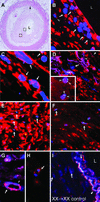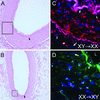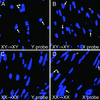Smooth muscle cells in human coronary atherosclerosis can originate from cells administered at marrow transplantation
- PMID: 12665618
- PMCID: PMC153628
- DOI: 10.1073/pnas.0730743100
Smooth muscle cells in human coronary atherosclerosis can originate from cells administered at marrow transplantation
Abstract
Atherosclerosis is the major cause of adult mortality in the developed world, and a significant contributor to atherosclerotic plaque progression involves smooth muscle cell recruitment to the intima of the vessel wall. Controversy currently exists on the exact origin of these recruited cells. Here we use sex-mismatched bone marrow transplant subjects to show that smooth muscle cells throughout the atherosclerotic vessel wall can derive from donor bone marrow. We demonstrate extensive recruitment of these cells in diseased compared with undiseased segments and exclude cell-cell fusion events as a cause for this enrichment. These data have broad implications for our understanding of the cellular components of human atherosclerotic plaque and provide a potentially novel target for future diagnostic and therapeutic strategies.
Figures




References
-
- Duguid J B, Robertson W B. Lancet. 1957;1:1205–1209. - PubMed
-
- Ross R, Glomset J A. Science. 1973;180:1332–1339. - PubMed
-
- Virchow R. Wien Med Wochenschr. 1856;6:825–829.
-
- von Rokitansky C. A Manual of Pathological Anatomy. Berlin: Berlin Sydenham Society; 1852.
-
- Ross R, Glomset J A. N Engl J Med. 1976;295:369–377. - PubMed
Publication types
MeSH terms
Grants and funding
LinkOut - more resources
Full Text Sources
Other Literature Sources
Medical

